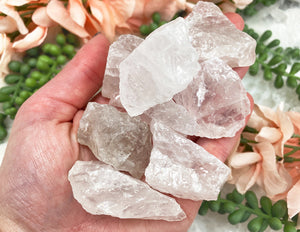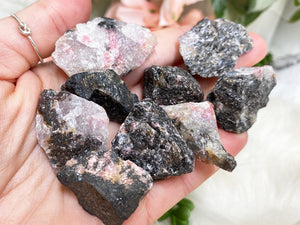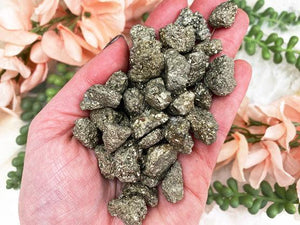Crystal Identification
Found yourself wondering 'what crystal is this?' or looking for help with crystal identification of a piece that came in one of our orders? Every Contempo Crystals order comes with crystal gift stones. If you are curious which crystals you received, take a look at the crystal identification chart below. You can tap the 'learn more about' link on some crystals for an in-depth description and photos to help further with your crystal identification! You'll also find some additional helpful crystal identifier tips at the bottom of the page!
**If you're here to identify crystals, I’d still love for you to check out the pieces I have available—here is the
crystal shop online
Please use your best guess in which crystal you receive as a freebie as I cannot identify everyone's personally. Thank you again!
While you don't get to select your free crystals, it is said a crystal will select you when you need it!
Crystal Identification Chart
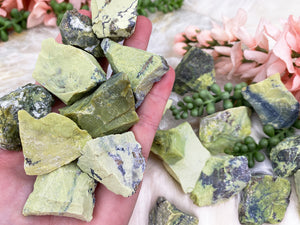
Opaque vibrant yellow or light green to deep green. Black/gray lining or spots. Occasional pyrite. Learn more about Green Serpentine >
Overall green color with hints of brown, black or white. Has a slight 'shine' finish to it. Learn more about Green Calcite >
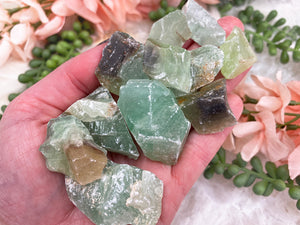
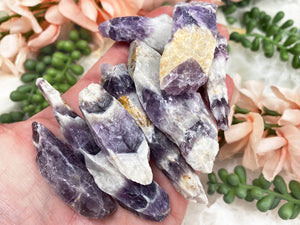
Purple and white coloring happening in a 'chevron' or stripe pattern. Usually a 'wand' shape. Learn more about Chevron Amethyst >
Black 'glass-like' appearance. As this is glass created by volcanos. Learn more about Black Obsidian >
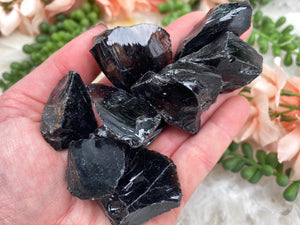
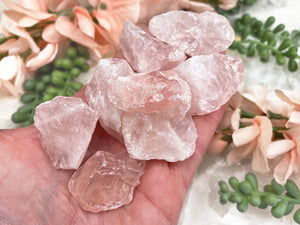
Even overall pink color. Ranges from baby pink to a more saturated color. Learn more about Rose Quartz >
Chalky white coloring with lines of gray. Very opaque in coloring. Learn more about Howlite >
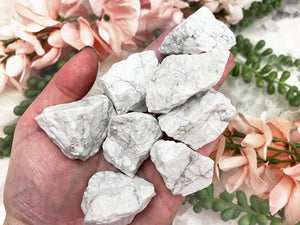
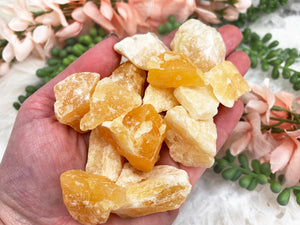
Light orange yellow coloring. Opaque soft stone with hints of white. Learn more about Calcite >
Incredibly soft white stone. There is obvious lining in to formation. Learn more about Selenite >
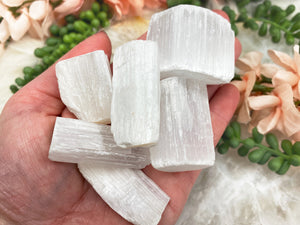

Overall green color. Soft mica stone with a subtle shimmer.
Even and overall light tan to deep brown color. Mostly clear. Learn more about Smoky Quartz >
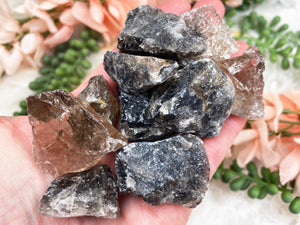
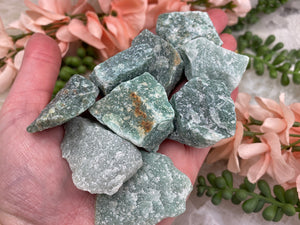
Even opaque green matte color with a subtle 'white' speckle. Learn more about Green Aventurine >
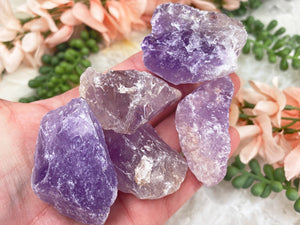
Overall translucent purple coloring with hints of opaque quartz. Learn more about Amethyst >
Very matte soft stone with lining in gray hues from almost white to black.
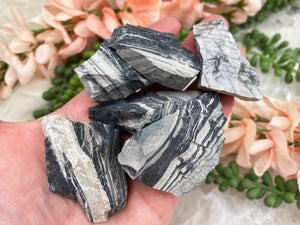
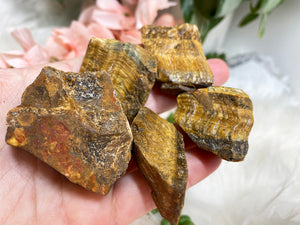
Shades of brown and orange. Some sections may 'shine' like cat eyes. Learn more about Tiger Eye >
Pink, Black & Gray opaque coloring with hints of tan and white. Learn more about Rhodonite >
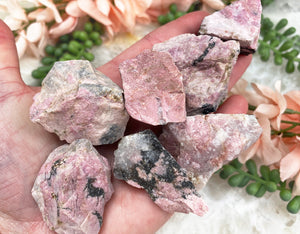

Looks opaque evenly white in color. No transparency at all. Also called white jasper.
Mostly opaque white in color with green lining throughout. May have quartz.


Jet black in color, very soft and can be flaky. Mixed with quartz and mica. Often has lines or 'rods'. Learn more about Black Tourmaline >
Mostly tan in color with hints of yellow from iron. Can be 'smoky'. Hard polished with clarity. Learn more about Citrine >
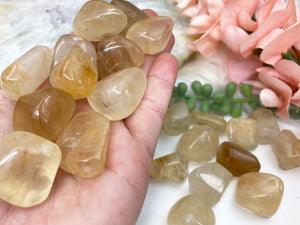
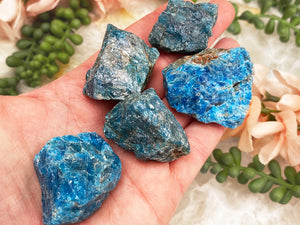
Vibrant to deep blue. Some white & orange spots. Slight clarity.
A soft matte jasper with mostly red, white, yellow color. Some pink.

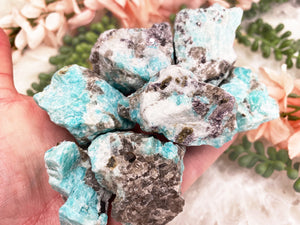
Blue, and sometimes White & Gray, Opaque coloring. Hints of Smoky Quartz & Lepidolite in some. Learn more about Amazonite >
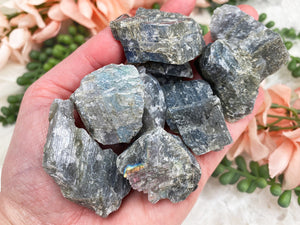
Overall even gray coloring. May have spots of colorful 'flash' at angles. Learn more about Labradorite >
Blue, White and/or Black stone with a matte finish. Opaque throughout. Learn more about Sodalite >
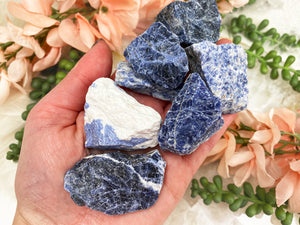
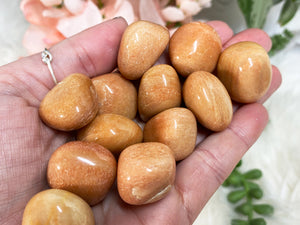
Overall orange color with slight yellow. Slight speckled appearance.
There are TONS of stones in this mix. Please use the rest of this guide to make your best guess.

Orange almost red color with white. Has a shine coating on it. Learn more about Calcite >
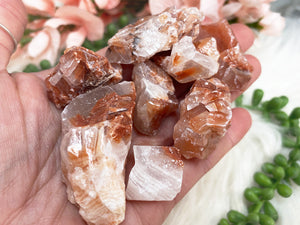
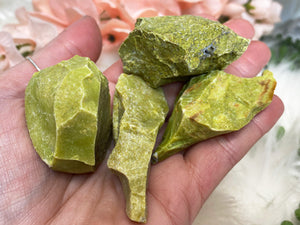
Nearly solid color of green/yellow with a matte finish. May have black spots and/or pyrite! Learn more about Green Serpentine >
Opaque in color but with a slight shine. Deep greens and yellows. Learn more about Ocean Jasper >
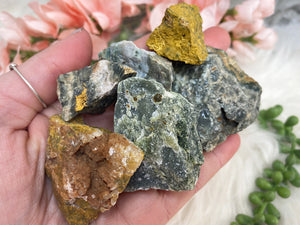
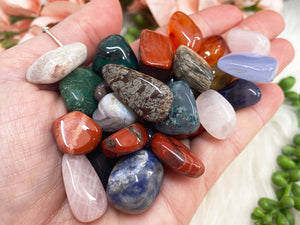
There are TONS of stones in this mix. Please use the rest of this guide to make your best guess.
Soft flaky raw crystal with an overall light lavender/purple color. Has an overall shimmer. Learn more about Lepidolite >

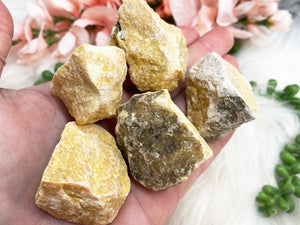
An even yellow opaque stone. May have dark spots on some sides.
A slightly cubic formation in a light blue, sometimes grayish color. Overall shine finish. Learn more about Calcite >
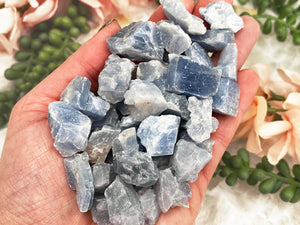
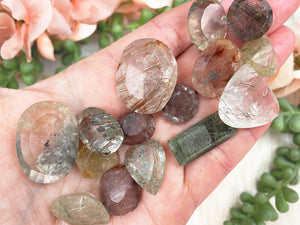
Clear to smoky quartz with tan, gold or brown rutile lines that shine. Learn more about Rutilated Quartz >
Opaque coloring of black, gray & purple. May have a silver flash.
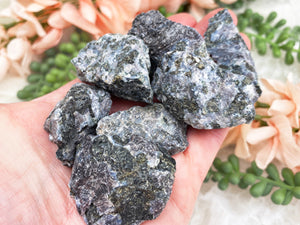
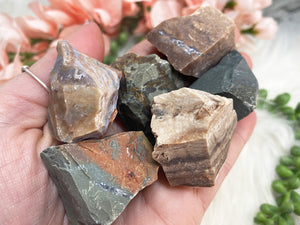
Matte opaque stone that is mostly gray with other colors mixed in.
A cute baby to bright pink mixed with white quartz or albite. Some may have 'rod' formations. Matte, not shiny. Learn more about Tourmaline >
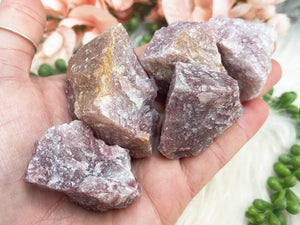
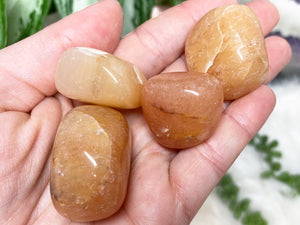
Overall orange coloring. Fairly even. Opaque but with some clarity.
Mostly white or light gray with black lines (like lightning) all over.

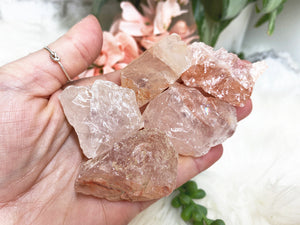
Clear quartz with pink to orange from hematite mixed in.
Overall even white opaque coloring. May have a very subtle shimmer. Learn more about Onyx >

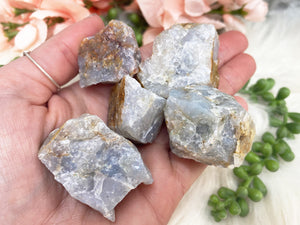
Light blue gray color that is mostly opaque, but has some clarity.
Opaque coloring of brown, teal, pink, yellow and more. Learn more about Polychrome Jasper >
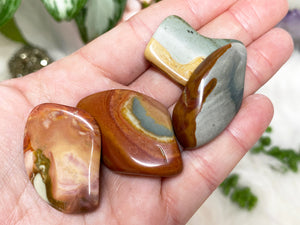
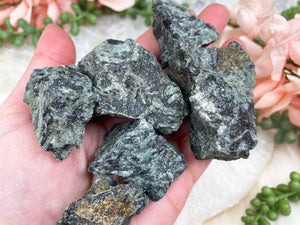
A matte green and black mixed gabbro stone with a slight shimmer.
Orange and white spotted stone. Opaque with a bit of shine to the orange spots.
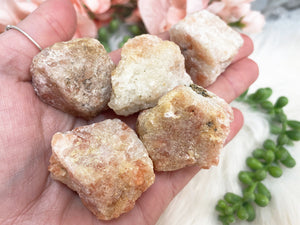
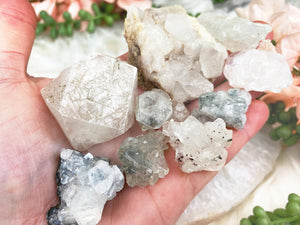
White or gray coloring with a raw cluster formation. Some sparkles. Learn more about Apophyllite >
Green to purple coloring. Somewhere between clear and opque. Learn more about Fluorite >
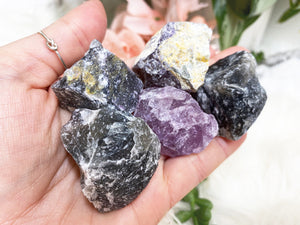
Crystals Healing Chart
Identifying crystals and rocks can be quite a puzzle, and the variations within each mineral family can really be astonishing. It's almost like they have a secret language of their own, with different dialects spoken by crystals from different locations, inclusions colors and more, giving them unique personalities, and even the part of the stone they originate from, known as their matrix, adding another layer of complexity. The world of crystals is a kaleidoscope of colors, shapes, and sizes, and each variation tells a story of its formation and journey through the Earth's crust.
When setting out on the quest to identify crystals, you're essentially becoming a crystal detective, relying on your sharp observational skills. You start by examining the basics: color, shape, clarity, surface, and size. However, even these seemingly straightforward characteristics can lead you on a wild goose chase, as crystals can be chameleonic, showing different colors depending on their impurities or environmental factors.
To crack the crystal code, you'll delve deeper into their secrets by looking at their texture and surface features. It's akin to examining the texture of a fingerprint, where each ridge and groove tells a unique story. Yet, the crystal world's intricacies don't end there. Sometimes, to definitively solve the mystery, you may need to resort to more advanced testing methods, such as hardness tests or specific gravity tests, to confirm their true identity. So, identifying crystals is not just a science; it's an art, a puzzle, and an adventure all rolled into one. To truly be sure of a crystal and it's mineral makeups, you can even send them off to be professionally tested!
Stone Identification
You can also take a look around the website and see even more examples of crystals and what they look like. For example, you could head to the 'amethyst crystals' and get a look at tons of different amethyst varieties because each product listed is going to be unique! Or perhaps looking at crystals by color, or by the stone type might help you with your identification.
- - - - -
Visit our quick Crystals & Their Meanings page for more helpful information on crystal meanings or tap into any of the crystals above! Even more crystal 'about' info on the collection pages mentioned above as well.
Hope this page helps a little with your crystal identification! There are also some great crystal book options that might be able to help you out. I've listed out some of my favorite books on that link and give a little description on why and what topics they cover like geology versus metaphysical focus.
THANK YOU AGAIN!!
- VISIT THE CRYSTAL SHOP -

